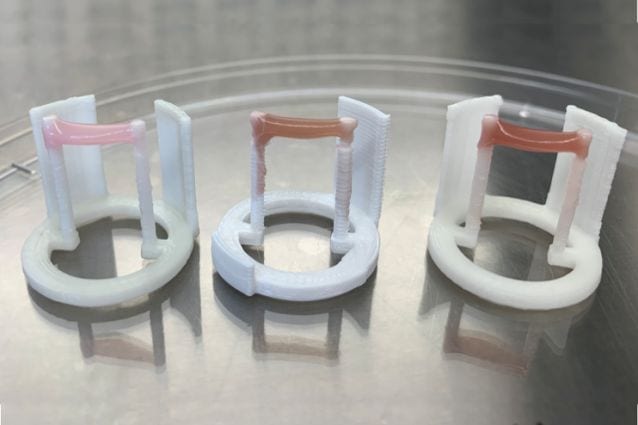
via University of Tokyo
Humans are largely omnivores, and meat in various forms has always featured in the diet of most cultures. However, with the increasing population and pressure on the environment, traditional methods of meeting this fundamental food requirement are likely to fall short. Now, researchers at the University of Tokyo report innovative biofabrication of bovine muscle tissue in the laboratory that may help meet escalating future demands for dietary meat.
With global urbanization, the economics of animal husbandry are becoming unsustainable. From an environmental viewpoint, the land and water costs of modern mega-scale livestock farming are untenable, as are the greenhouse gas emissions and the overall toll on the planet. Additionally, ethical concerns against inhuman exploitation of lower species for food are increasingly being voiced.
To address future requirements, tissue engineering of cultured meat is under development at several centers worldwide. However, most biosynthetic meat products are amorphous or granular-like minced meat, lacking the grain and texture of real animal flesh. Mai Furuhashi, lead author, explains their novel process. “Using techniques developed for regenerative medicine, we succeeded in culturing millimeter-sized chunks of meat wherein alignment of the myotubes help mimic the texture and mouthfeel of steak. For this, myoblasts drawn from commercial beef were cultured in hydrogel modules that could be stacked allowing fusion into larger chunks. We determined the optimal scaffolding and electrical stimulation to promote contractility and anatomical alignment of the muscle tissue to best simulate steak meat.”
Lead author, Yuya Morimoto, describes the synthesized product. “Our morphological, functional and food feature analyses showed that the cultured muscle tissue holds promise as a credible steak substitute. Breaking force measurements showed that toughness approached that of natural beef over time. Significantly, microbial contamination was undetectable; this has implications for cleanliness, consumer acceptability and shelf-life.”
“Our method paves the way for further development of larger portions of realistic cultured meat that can supplement or replace animal sources,” claims Shoji Takeuchi, senior and corresponding author. “However, there is a long way to go before lab-grown meat is indistinguishable from the real thing and hurdles concerning consumer acceptance and cultural sensibilities are overcome. Nevertheless, this innovation promises to be a green and ethical alternative to animal slaughter in meeting our need for dietary meat.”
Original Article: Meeting the meat needs of the future
More from: University of Tokyo
The Latest Updates from Bing News & Google News
Go deeper with Bing News on:
Cultured meat
- Alabama House approves ban on meat from cultured animal cells
Last year, the USDA and the FDA for the first time approved companies to produce cell-cultivated meat products to be sold in the United States.
- Could this pink rice be the food of the future? Scientists say it’s more nutritious than normal rice
A South Korean research team has developed a new hybrid food, an affordable and eco-friendly source of protein, in a bid to develop a sustainable future option.
- What do consumers think about lab-grown meat?
Consumers prefer conventionally grown meats versus lab-grown meats, according to Purdue University’s March Consumer Food Insights Report.
- The GOP's got a growing beef with lab-made meat
The industry of lab grown meat is still in its infancy, but that hasn't stopped politicians from trying to turn it into a culture war issue.
- Cultured Quail? It’s Available in Singapore
Australian company Vow this month received regulatory approval from Singapore Food Agency for a rare lab-grown meat.
Go deeper with Google Headlines on:
Cultured meat
[google_news title=”” keyword=”cultured meat” num_posts=”5″ blurb_length=”0″ show_thumb=”left”]
Go deeper with Bing News on:
Tissue-engineered meat
- Bird flu virus in milk poses challenges for dairy industry
The discovery of fragments of avian flu virus in milk sold in U.S. stores, including in about 20% of samples in initial testing, suggests that the H5N1 virus may be more widespread in dairy cattle ...
- Could this pink rice be the food of the future? Scientists say it’s more nutritious than normal rice
A South Korean research team has developed a new hybrid food, an affordable and eco-friendly source of protein, in a bid to develop a sustainable future option.
- Woman becomes 1st patient to undergo combined heart pump implant and pig kidney transplant
In a first-of-its-kind procedure, a terminally ill New Jersey woman received a pig kidney transplant and a surgically implanted mechanical heart pump.
- Experts tell lawmakers about harmful effects of microplastics
One expert cited a link between the creation of plastic and dramatically declining fertility rates and sperm counts. The post Experts tell lawmakers about harmful effects of microplastics appeared ...
- Scientists fabricate composites that combine high strength and bioactivity inspired by the cortical bone
Researchers have created scaffolds with enhanced strength by fabricating 20 vol% polydopamine-modified nano hydroxyapatite (pDA-nHA), featuring a distinctive lamellar structure. These scaffolds were ...
Go deeper with Google Headlines on:
Tissue-engineered meat
[google_news title=”” keyword=”tissue-engineered meat” num_posts=”5″ blurb_length=”0″ show_thumb=”left”]
[embedyt] https://www.youtube.com/embed?listType=playlist&list=PL0UjJ07OSXC83oV409r1yRju8-ihA1InJ&layout=gallery[/embedyt]










